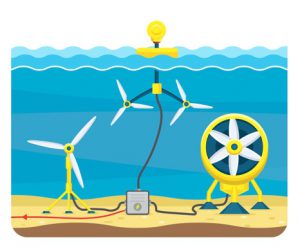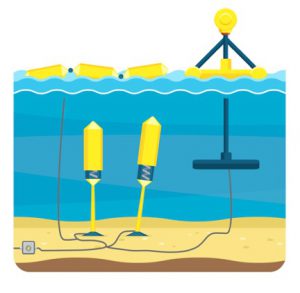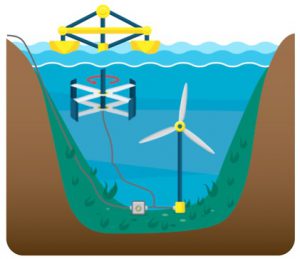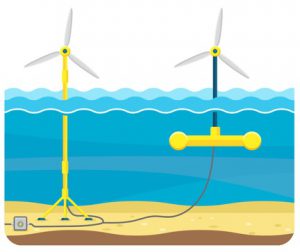Why marine renewable energy?

The majority of the Earth’s surface is composed of moving water. All of it contains energy.
Ocean waves, tides, salinity, temperature differences and river currents can all be used to generate electricity.
Countries across the world – including, Canada, Chile, China, Denmark, France, Indonesia, Ireland, Norway, Portugal, Spain, Sweden, the Republic of Korea, the UK, the US and others – have begun to explore the potential of marine renewable energy to contribute to our global electricity supply.
In Canada, the main sources of marine renewables are:
Tidal energy: Powerful and predictable. Tides are created by the gravitational pull of the sun, moon and the rotation of the earth, all of which can be predicted years in advance. Tidal technologies – often working like windmills underwater – can generate electricity by harnessing their natural ebb and flow.
Wave energy: Wind into water power. As wind passes over the surface of the ocean, it creates waves that can spin a turbine – either from directly from the surface waves, or from different pressure fluctuations between the ocean surfaces.
River current: Always flowing. Running downstream from its source, a river can provide continuous energy. Its power – just like tidal – is derived from the volume and speed of the water flow. River devices can be installed on existing bridges and infrastructure, bringing big cost savings.
Offshore wind: Strong and steady. Wind turbines are a well-known technology, and offshore wind offers stronger and more predictable energy than onshore wind resources. While offshore wind levels vary, they are more easily forecast – up to several days in advance.
The Benefits
Clean energy, clear air Tides, waves, and river currents are clean, sustainable sources of energy. Canada has an estimated tidal energy potential of 35,700 megawatts (MW). That’s enough clean power to displace over 113 million tonnes of CO2 – equal to removing over 24 million cars off the road. When we add wave and river, that number soars to 340 gigawatts: enough energy to power every home in Canada five times over!
Reliability and diversity Energy diversity creates energy security. Adding marine renewable energy to the energy mix ensures electricity customers aren’t overly dependent on a single source – helping stabilize energy supply and pricing. Marine renewable energy is consumed locally, enhancing a community’s energy independence – it’s right on site. It is also reliable: unlike highly variable sources like wind and solar, tidal energy can be predicted for years (and wave energy is more than twice as predictable as wind and solar).
An opportunity for remote, Indigenous, and rural communities In Canada, a total of 251 remote communities have their own fossil fuel plants, with 176 of these fueled by imported diesel. The majority of the remote communities are Indigenous; all stand to benefit from, as Nuu-chah-nulth Tribal Council President Judith Sayers puts it, “a vibrant and long term decentralized renewable energy sector.” Marine renewable energy offers a remote community solution that is cost competitive, avoids emissions, and creates jobs.
Economic growth It’s not just about clean energy: it’s also about jobs. Over 300 companies have already found work in the Bay of Fundy’s emerging tidal energy sector. With an estimated global market potential of $900 billion, Canada’s supply chain could capture $45 billion by 2050 with even a 5% market share. Canada’s strengths in marine fabrication, shipbuilding, shipping, offshore oil, and ocean technology sectors directly translate to marine renewable energy project development.
The Challenges
Working in harsh environments Working in high flow marine environments means using heavy equipment – vessels, cables, and winches – to get the job done. It also means managing tight time windows to negotiate high currents, weather, and darkness. All that brings cost, particularly as different technologies and approaches are in the testing phase.
Environmental interactions The international research is encouraging: there have been no significant environmental effects over the first 10 years of global marine renewable energy activity. But the public still requires clear and convincing evidence that any marine renewable energy impacts are acceptable. As we know from the wind sector, this can take time.
Infrastructure needs The best marine renewable resources are located in areas with high flows and/or high winds; these areas typically may have little immediate infrastructure. That needs to change – in order to make it easy and affordable to quickly deploy and maintain devices.




